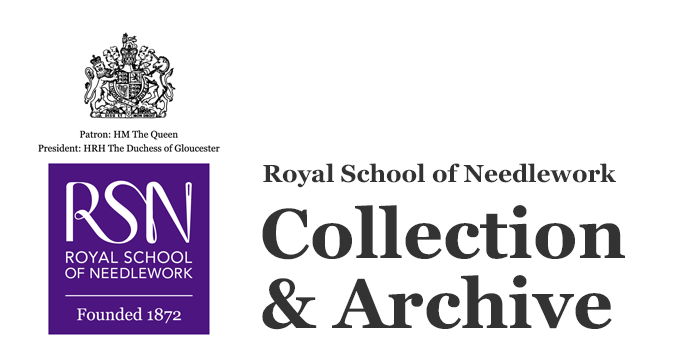Sampler
Object name
Maker
Organisation
Date made
Circa 1956
Place made
Description
Blackwork sampler with gold threads, made by Dorothy Abnett at the Royal School of Needlework's Night School in the the second half of the 1950s.
Content description
Blackwork technique sampler worked by Dorothy Abnett involving black cotton and gold threads on bleached linen. This piece was worked in the Royal School of Needlework's Night School. The sampler comprises outline shapes that are filled in with different blackwork patterns which have been further embellished with the use of fine gold thread. This combination of black and gold was a hallmark of pieces from 1950s.
The sampler features stylised birds, flowers, and foliage. The outlines have been created using both black and gold threads. The black outlines have been done in stem stitch. For the gold threads, passing threads have been couched down with cotton thread and twist threads have been stitched down through the twist. The design has been filled with a variety of different blackwork patterns (diapers), which have been further embellished with the use of fine gold thread. Blackwork patterns featured in this piece include variations on honeycomb and tulip. The blackwork patterns are worked in double running stitch.
The embroidery, which is mounted but not framed, was created by Dorothy Abnett who was a technical evening student at the Royal School of Needlework from 1956.
In the 1890s there was a push by the government to promote technical education and Princess Helena, the Royal School of Needlework's patron, wanted to be seen at the forefront of this movement. In 1895 the RSN’s governing body agreed to launch a new training programme, a two-year Certificate or a three-year Diploma, holders of which would be able to teach in schools or in the new technical colleges. Graduates went on to teach not just in the UK, but all over the world.
A short while later, the RSN’s governing Council became aware that many of those teaching embroidery in the technical colleges were self-taught and so they proposed offering evening classes. These would run five nights a week: two on embroidery, two on design, and one night for what the RSN called ‘Work on Own’, when there would not be any teaching but the classroom would be open for students to do their own work. This was an important provision as many students did not have space at home to set up frames. The evening school classes were launched with a lecture by Walter Crane.
The Training School Diploma ran until 1961 when it was stopped abruptly after the Ministry of Education wanted significant changes and the RSN did not have the funds to put these in place. With the exception of a break during World War II, evening school classes continued until the end of the 1980s when, with the move to Hampton Court Palace, there was no longer a suitable, accessible setting for such classes.
The sampler features stylised birds, flowers, and foliage. The outlines have been created using both black and gold threads. The black outlines have been done in stem stitch. For the gold threads, passing threads have been couched down with cotton thread and twist threads have been stitched down through the twist. The design has been filled with a variety of different blackwork patterns (diapers), which have been further embellished with the use of fine gold thread. Blackwork patterns featured in this piece include variations on honeycomb and tulip. The blackwork patterns are worked in double running stitch.
The embroidery, which is mounted but not framed, was created by Dorothy Abnett who was a technical evening student at the Royal School of Needlework from 1956.
In the 1890s there was a push by the government to promote technical education and Princess Helena, the Royal School of Needlework's patron, wanted to be seen at the forefront of this movement. In 1895 the RSN’s governing body agreed to launch a new training programme, a two-year Certificate or a three-year Diploma, holders of which would be able to teach in schools or in the new technical colleges. Graduates went on to teach not just in the UK, but all over the world.
A short while later, the RSN’s governing Council became aware that many of those teaching embroidery in the technical colleges were self-taught and so they proposed offering evening classes. These would run five nights a week: two on embroidery, two on design, and one night for what the RSN called ‘Work on Own’, when there would not be any teaching but the classroom would be open for students to do their own work. This was an important provision as many students did not have space at home to set up frames. The evening school classes were launched with a lecture by Walter Crane.
The Training School Diploma ran until 1961 when it was stopped abruptly after the Ministry of Education wanted significant changes and the RSN did not have the funds to put these in place. With the exception of a break during World War II, evening school classes continued until the end of the 1980s when, with the move to Hampton Court Palace, there was no longer a suitable, accessible setting for such classes.
Dimensions
width: 34cm
height: 34cm
height: 34cm
Materials
Stitches
Double running stitch 
Stem stitch
Couching
Tulip (pattern)
Honeycomb (pattern)
Gold twist application

Stem stitch

Couching

Tulip (pattern)

Honeycomb (pattern)

Gold twist application

Techniques
Motifs
Credit line
Gift of Caroline Froom, 2014.
Catalogue number
COL.2014.25
Other numbers
RSN 2059
© Royal School of Needlework
